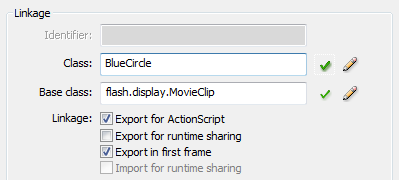by
kirupa | 28 May 2007
In the
previous page, you created your BlueCircle.as file
and copied and pasted some code. When you tested your
movie, you noticed that the blue circle you had on your
stage was now moving in a circular path. In this page,
let's look at the code and figure out what all of the
code you pasted does.
Let's look at each line of our code in BlueCircle.as in
detail:
- package
{
-
- ..
- ..
- ..
-
- }
The very first line of code in BlueCircle.as is our
package declaration. If
you are familiar with packages in other languages such as
Java or namespaces in .NET, this should be very familiar to
you.
In a nutshell, a package is like a folder under which all
of your classes can be referenced through. I am not going to
dwell too much on packages in this tutorial, for I plan on
covering them in greater detail later. In this case, I am
not specifying a package name, so specifying them is more of a formality than something that you need to
consciously keep in mind when writing your code.
Let's move on:
- import
flash.display.*;
- import
flash.events.*;
The above two lines are import statements. In ActionScript
3, whenever you need to use functionality found in built-in
classes, you will need to reference the path to the classes
via import statements. For example, you will soon find that
I use the enterframe event to create my animation. Unless I
actually import the various event-related classes as shown
above, the compiler will have no idea what an enterframe
event actually is.
- public
class
BlueCircle
extends
MovieClip
{
- ..
- ..
- ..
- }
This line is probably the most important line in this
application. Here, I define my BlueCircle class. If you
recall, when you created your circle movie clip earlier, you
specified the name of the class:

With the above line of code, you create the magical link
between your movie clip in your Library and the BlueCircle
class you just created.
There is another important thing to note about our
BlueCircle class definition. I am using the
extends keyword to let the
compiler know that BlueCircle is basing a lot of its
functionality from the MovieClip class. This is important
because, like you see in the above screenshot, the base
class for our movie clip is
flash.display.MovieClip.
So, why am I not writing
BlueCircle extends flash.display.MovieClip? If you
check a few lines earlier, you already imported
flash.display.*, and the
* wildcard allows you to get away with using any class
stored inside flash.display
without fully specifying its name. That is why I
simply write extends MovieClip
as opposed to the longer variant I just asked about.
- var
radians
= 0;
- var
speed
= 0;
- var
radius
= 5;
The first five lines inside our BlueCircle class are
pretty straightforward. I am declaring five variables that I
will be using, and the radians,
speed, and
radius variables are
initialized to some default values. I wish I had more to say
about them, but I don't, let's move on :-P
- public
function
BlueCircle()
- {
- ..
- ..
- ..
- }
If the class definition was the most important line of
code in this movie, then our BlueCircle constructor shown
here would be the second most important line of code. A
constructor is the name for a method that gets called
whenever you create new instances of a class. That probably
made no sense, let's kick it down a few notches.
Each time you drag and drop a new circle movie clip from
your library, you are basically creating a new user of of
your BlueCircle class. A user of a class is known as an
instance. Whenever you create a new instance by inserting
another circle movie clip into your stage, a method whose
name is the same as that of your class gets called. That
method is known as a constructor. That is what you see
above.
Notice that our class is called BlueCircle, and our
constructor's name is also called BlueCircle. With the
exception of it being called when an instance is created, a
constructor is largely the same as any regular method. For
you long-time AS programmers, feel free to add functionality
in your constructor that you used to add in an OnLoad event!
Ok, so far we've covered most of the important parts of
our code that are relevant to seeing the link between movie
clips and classes. There is still some code left to cover,
but let's first look at how to actually use this movie clip
both manually and programmatically.
Onwards to the
next page!
|